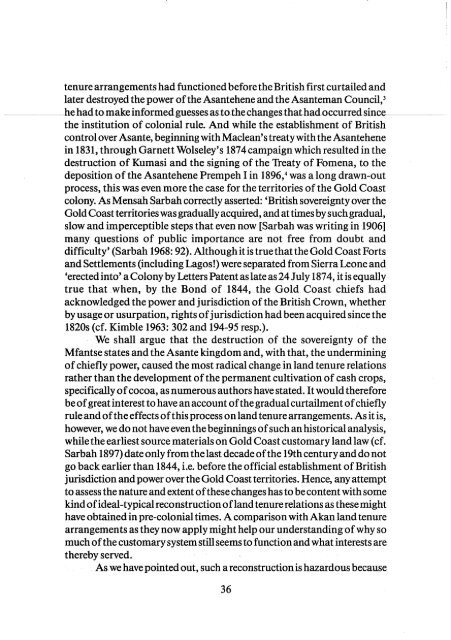Create successful ePaper yourself
Turn your PDF publications into a flip-book with our unique Google optimized e-Paper software.
tenure arrangements had functioned before the British first curtailed and<br />
later destroyed the power of the Asantehene and the Asanteman Council, 3<br />
he had to make informed guessesastothechanges thathadoccurred since<br />
the institution of colonial rule. And while the establishment of British<br />
control over Asante, beginning with Maclean's treaty with the Asantehene<br />
in 1831, through Garnett Wolseley's 1874 campaign which resulted in the<br />
destruction of Kumasi and the signing of the Treaty of Fomena, to the<br />
deposition ofthe Asantehene Prempeh I in 1896,4 was a long drawn-out<br />
process, this was even more the case for the territories of the Gold Coast<br />
colony. As Mensah Sarbah correctly asserted: 'British sovereignty over the<br />
Gold Coast territories was gradually acquired, and at times by such gradual,<br />
slow and imperceptible steps that even now [Sarbah was writing in 1906]<br />
many questions of public importance are not free from doubt and<br />
difficulty' (Sarbah 1968: 92). Although it is true thatthe Gold Coast Forts<br />
and Settlements (including Lagos!) were separated from Sierra Leone and<br />
'erected into' a Colony by Letters Patent as late as 24 July 1874, it is equally<br />
true that when, by the Bond of 1844, the Gold Coast chiefs had<br />
acknowledged the power and jurisdiction of the British Crown, whether<br />
by usage or usurpation, rights of jurisdiction had been acquired since the<br />
1820s (cf. Kimble 1963: 302 and 194-95 resp.).<br />
We shall argue that the destruction of the sovereignty of the<br />
Mfantse states and the Asante kingdom and, with that, the undermining<br />
of chiefly power, caused the most radical change in land tenure relations<br />
rather than the development of the permanent cultivation of cash crops,<br />
specifically of cocoa, as numerous authors have stated. It would therefore<br />
be of great interest to have an account of the gradual curtailment of chiefly<br />
rule and of the effects of this process on land tenure arrangements. As it is,<br />
however, we do not have even the beginnings of such an historical analysis,<br />
while the earliest source materials on Gold Coast customary land law (cf.<br />
Sarbah 1897) date only from the last decade ofthe 19th century and do not<br />
go back earlier than 1844, i.e. before the official establishment of British<br />
jurisdiction and power over the Gold Coast territories. Hence, any attempt<br />
to assess the nature and extent ofthese changes has to be content with some<br />
kind of ideal-typical reconstruction ofland tenure relations as these might<br />
have obtained in pre-colonial times. A comparison with Akan land tenure<br />
arrangements as they now apply might help our understanding of why so<br />
much of the customary system still seems to function and what interests are<br />
thereby served.<br />
As we have pointed out, such a reconstruction is hazardous because<br />
36
















